Welcome to Reverse Stall Parking
Reverse stall parking, in other words, backing into a parking space – especially when it’s between two very shiny-looking objects – is not something most student drivers get excited about.
It’s hard enough trying to drive forwards! But, this is of course a necessary skill that can be made much easier by practicing your basic backing skills first. Let’s dive right in. And for a related article, check out Right-of-Way in the Parking Lot.
What Is Reverse Stall Parking?
Reverse stall parking is something new drivers and learners hear about when learning how to drive. And, you need to know how for your ICBC road test. But what is this mysterious thing? Reverse stall parking = how to back into a parking spot.
This article will discuss:
- How to reverse into a parking spot
- Why you should reverse into a parking stall
- Reverse parking tips and techniques
- How to correct your parking if it’s not quite good

What Is The Main Reason For Reverse Parking?
It’s a good question, wondering about why we should reverse into a parking spot rather than simply drive forwards into it. There are at least 5 reasons I can think of: your visibility is better, it’s safer, it prevents unnecessary insurance claims, you can leave the parking spot faster, and it’s better in case of mechanical failure when parked.
The first thing to realize is that unless you can do the ‘pull-through’ method, then, either way, you will have to do some reversing. You will have to reverse into the spot, or you will have to reverse to get out of the spot, right?
What’s the difference?
As it turns out, there’s a big difference.
Visibility When Reverse Stall Parking
If you reverse into the spot, you can check out the space you’ll be reversing into immediately before you reverse into it.
If you drive forward into a space, and then go shopping at the mall (for example).. once you return, you will be forced to back out into a space in which things may be constantly changing.
You will have no idea if there are cars coming, people about to walk behind you, kids, dogs, or any other vehicle backing up.
Parking Lot Safety When Reverse Stall Parking
Reverse Stall Parking Is Safer
If you drive forwards into space when you come back to your vehicle, there could be different vehicles parked beside you than were there when you left. This means larger vehicles than yours could now be totally blocking your view.
This would leave you with zero visibility; basically leaving you no choice but to blindly reverse out into the parking area.
If you are stuck in this situation, you could use a spotter if you have one. Or you could honk your horn before reversing to alert others. But the truth is, a lot of drivers drive alone, and wouldn’t normally have access to a spotter.
The other thing that happens sometimes is the vehicle that parks beside you, might not park very well. It might be very close to your vehicle, and/or on a weird angle. In those cases, it’s just easier to get out by driving forwards rather than by reversing. You don’t want that feeling like you’re reversing through a Jenga game.
Reverse Stall Parking & Insurance
The insurance rules may be working against you. Legally, we must not reverse unless it is safe. If you don’t know if it’s safe because you have no visibility, it’s hard to make good decisions.
It sounds obvious, but this means if two vehicles collide in a parking lot, and one of them was going forwards and one of them was going backward, then the fault is likely placed on the vehicle that was backing.
This seems to be true even if the backing driver was carefully (but blindly) backing out, and the driver in the car going forwards was totally inattentive, distracted, or even speeding. People who are backing tend to simply get screwed.
Speed, Duration, and Ease When Reverse Stall Parking
Say for some reason you need to leave the parking lot very quickly, like, as quickly as possible. I will leave it up to your imagination to determine what those reasons might be.
It will be much quicker and easier for you if your car is all ready to go because you’ve already done the reverse stall parking. If your car needs to be unparked, especially when it is dark or if you’ve just left the movie theater or busy shopping mall, it will take more time.
Who has the right of way when 5 different vehicles are all trying to reverse into the same space at the same time? Does anyone know? How easy is it to make eye contact or communicate with those other drivers? It is so much easier to just drive away when your car is already pointing forwards.
Mechanical Problems
If your car happens to break down while parked, and you’ve done the reverse stall parking into the space, it will be a better deal.
It will be easier to access your hood to jump-start your vehicle or have the vehicle accessed by the tow truck perhaps.
This actually happened to me once and I was so happy that my large van was facing forward and was easily accessible for the tow truck.
How To Reverse Park: Reverse Parking Technique
This is just one way that you could reverse stall park. There are some others, but I have found this to be the easiest.
Step 1: Look For a ‘Pull Through’ Spot
Whenever possible, do the pull-thru method so that you never need to reverse it whatsoever.
Of course, this is not always possible but look for the opportunity. It is probably the all-around safest, fastest, and easiest way to park in a parking lot.
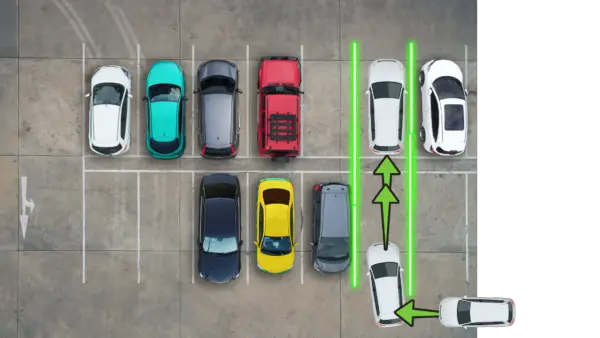
Step 2: Make Sure You Select A Good Spot
When selecting a spot, don’t just randomly pick the first one that you see.
- Make sure the spot is big enough for your vehicle.
- It should be well-lit if at night to avoid being a target for thieves.
- Parking near a high-pedestrian area works well too if you’re concerned about auto theft.
Check out the space for any obstacles in the space, such as a shopping cart, or broken glass that you may not want to drive over
What type of situation do you have at the rear of the spot; i.e. is there a wall, a tree, a little cement barrier, another vehicle over the line, etc.
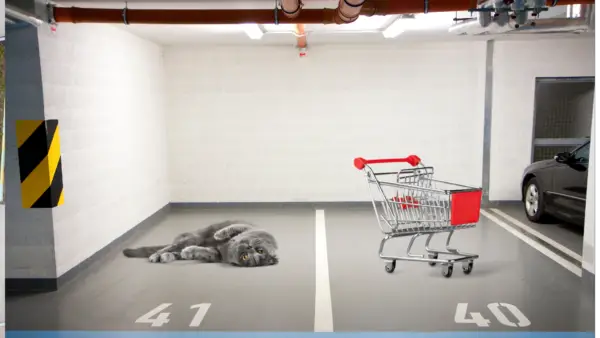
Step 3: How To Back Into a Parking Spot
Pull up relatively close to the spot that you intend to park in and signal your intentions. In this example we are going to be backing to the right, so we’ll use the right signal.
This way, other people will be able to tell what you’re doing and you will be minimizing the amount of reversing you’ll be doing, which is important in crowded places.
Signal early and stop (or slow) so that you can easily check out the space.
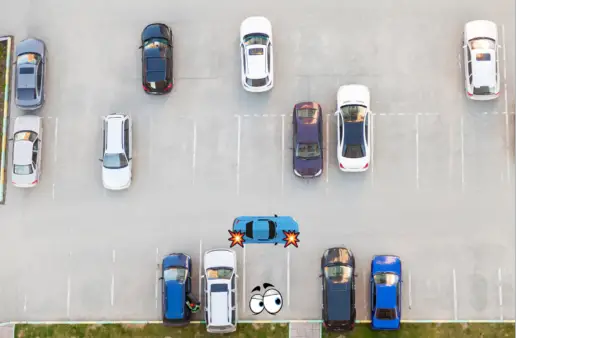
From here, drive forward and onto an angle that points the rear of the car toward the center of the space.
Like parallel parking, this is not an exact science and even if you do not quite get it the first time, you will still be able to get the car between the lines eventually, so do not panic. Remember you are just parking a car.
Ask yourself, what do I have to do to the front of the car in order to aim the rear of it into the center of the space?
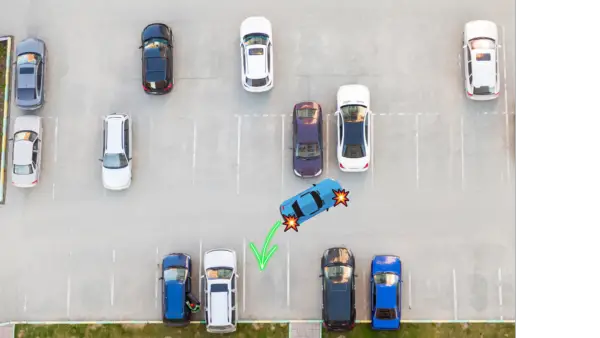
Step 4: Remember To Check Your Mirrors
As you’re slowly backing, check your side-view mirrors for the clearance between your vehicle and the one beside you; it should be a very obvious YES or NO that you have the clearance.
This is another advantage of reversing into the spot. You can easily tell if you’re going to have enough room. If you go forwards into a tight space, you can not see your front bumper while you are driving.
When you do reverse stall parking, there is no need to see your front or rear bumper. If there is no space between the vehicles (you’re too close) then simply pull forward and readjust it to give yourself more room.
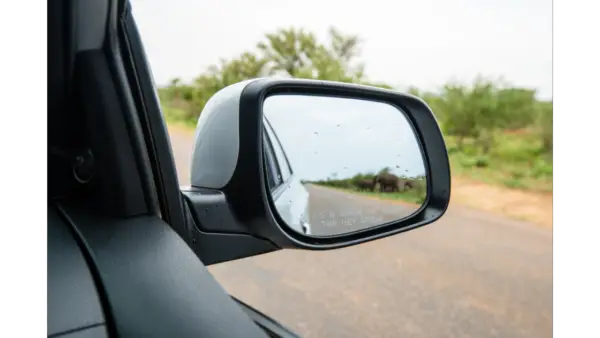
Step 5: When To Stop
If you’re not sure when to stop, sometimes it can work to try to line up your wheels with the wheels of the vehicle beside you as a rough guideline.
You could also line up your side-view mirror with the vehicle next to you, if the vehicle next to you is parked correctly, and has also reversed into the space, and is about the same size as yours.
Otherwise, put your car in park and get out and take a look (GOAL lol).
This is the only way to tell for sure and it is a lot better than accidentally bashing into something (Parking by braille, as Paul says)
Step 6: How To Fix Your Reverse Stall Parking
If it’s not quite perfect, it’s no big deal. You can simply pull forward and re-adjust it.
Backing in a straight line is pretty easy so if you can fix it first and then reverse in a straight line, that might be good; but you can also go forward in a straight line and then wiggle yourself backward and into the correct spot.
Remember your 360 checks every time before you reverse.
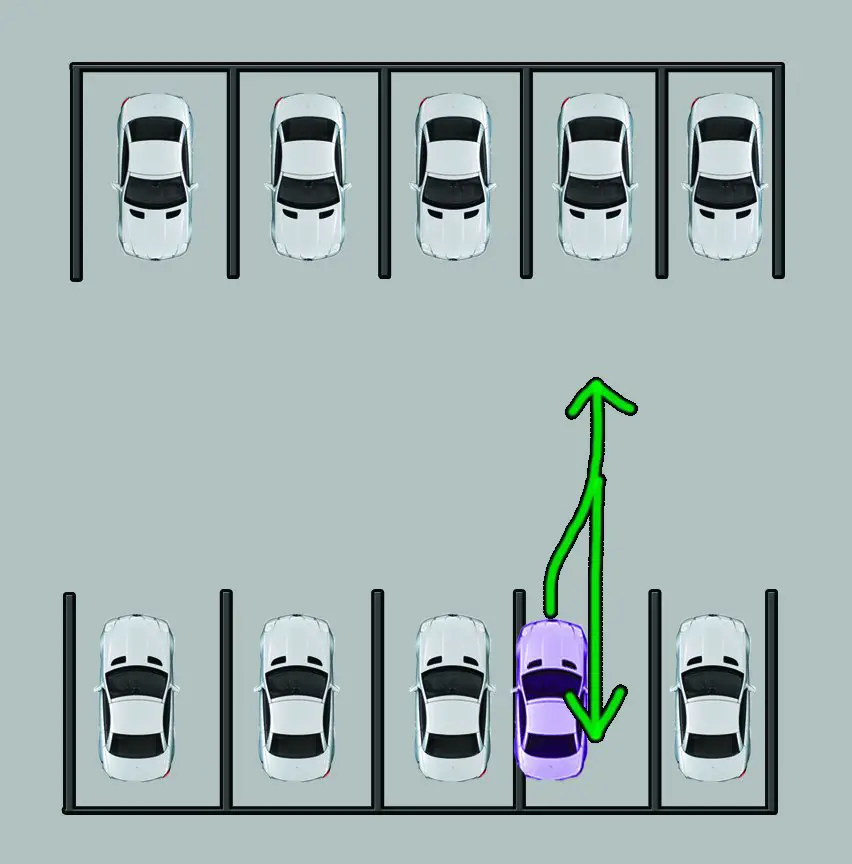
Step 7: Another Way Of Correcting Your Parking
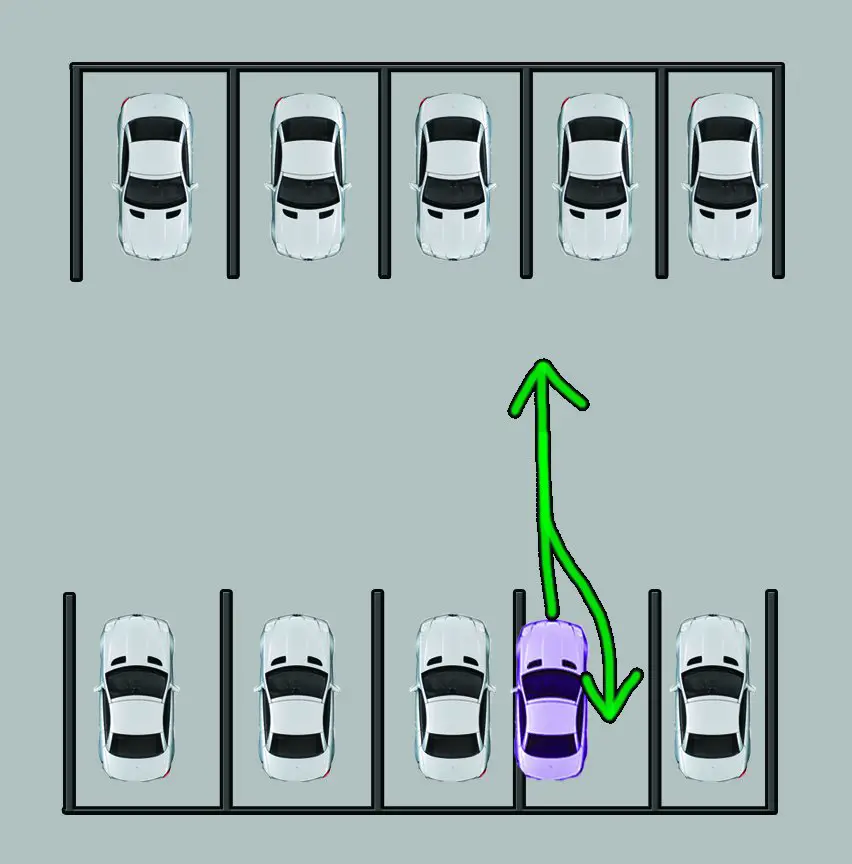
Step 8: Remember To Check Before Opening Your Door
Remember, before you open your door and become a pedestrian, check your mirror and shoulder check for people who may be walking beside your vehicle.
Conclusion
Reverse stall parking isn’t the easiest thing to do, but it gets better with practice, just like everything else. If you’ve never done basic backing skills, be sure to get a handle on those first before you try any kind of fancy parking like this or parallel parking.
There are a lot of advantages to backing into a parking stall. I suppose that’s why you’re required to do it on road tests everywhere. It’s a nice bonus after driving somewhere when you get to actually park the car and get out. Reverse stall parking is simply safer than driving forwards into a parking stall.
Parking lots come in second on the list of most common places where crashes occur, right after intersections. This is why it’s a good idea to try and reduce parking lot accidents. These aren’t usually dramatic, but no one needs them.
If you keep practicing, reversing into a parking spot does get easier. And it’s a great life skill that you’ll be able to use anywhere, no matter what car you’re driving. Read more on our blog: How to park your car on a hill
Related articles:
